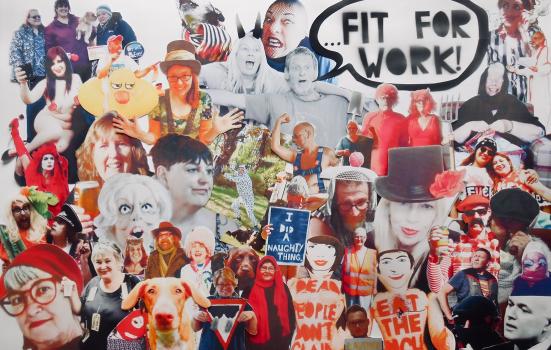The Scottish government may have put ‘build back better’ on the back burner, but contemporary art has not. Clare Harris celebrates the determination that characterises Scottish artists as they cling on through the pandemic.

The announcement of £1.57bn for cultural recovery and its associated £97m for Scotland seems like a lifetime ago. In July, the Scottish Contemporary Art Network (SCAN) team had already been gathering evidence from our members and the wide visual art community on the impacts of Covid-19 on their livelihoods, their organisations and their future.
Already, the Scottish Government had committed £12m to performing arts venues; our position was to propose a dedicated fund for visual arts, to ensure that the whole visual art ecology would receive the support it needed, both artists and organisations.
On 28 August, the Scottish Government announced a range of packages that looked like it could address our needs. Of that £59m package two funds seemed most pertinent to our sector; the £15m Cultural Organisations and Venues Recovery Fund (COVR) and the £5m Creative Freelancers Hardship Fund. We were heartened to hear First Minister Nicola Sturgeon’s announcement echoing what we had advocated for – the need for support across the whole of the arts infrastructure, to individuals as well as to the organisations – without either of which there would be no cultural sector in Scotland.
Uncertainty
As with everything in these fiendishly difficult times, the devil did come in the detail. The £15m fund was a competitive fund with key criteria around preventing loss of livelihood and insolvency by March 2021. As we stated in a letter to the Cabinet Secretary for Economy, Fair Work and Culture, ‘the wide scope of the fund means that resources will be stretched too thinly to be meaningful and … the assessment of not-for-profit cultural organisations alongside for-profit business risks creating long-term damage to the sustainability and viability of our sector.’
The decisions of the COVR fund will be landing at the beginning of November, and no doubt we will see a flurry of reaction similar to that around the English Cultural Recovery Fund decisions earlier this month. In a flash survey of our members we found that 62% of organisations did not apply – the primary reason being that they didn’t feel able to meet the criteria of insolvency before March 2021. For many, the cliff edge is certainly coming, but it isn’t coming within the window the Government have to get their funding out of the door. As furlough comes to an end and restrictions continue to impact income streams, key spaces used and loved by many across Scotland are facing an uncertain future as they move into the next financial year.
‘We have cancelled some public programmes and been extremely tough on imposing savings,’ said one survey respondent. ‘We need assistance, but the criteria have to be around adaptability to a new world rather than survival within an old paradigm.’ Another added: ‘COVR only addressed jobs and lost income rather than giving an opportunity to really address value or how to renew and recover.’
The £5m Creative Freelancers Hardship Fund is opening this week. Distributed for visual artists through Visual Arts Scotland, and for others working in the sector – technicians, curators, educators and more – through Creative Scotland, this fund will, like COVR, cover a wide range of need. The fear, as always, is that demand will significantly outstrip supply, and that there will be those who fall through the cracks. A quick look at the sums shows that, from the original £97m only a fraction remains. Our target now is in the next round of budget discussions.
Making things happen
It’s time more than ever to show exactly how contemporary visual art makes a real difference in our communities; and why it needs a more secure future. Last year SCAN’s Art in Action campaign successfully put MSPs together with our members to see how contemporary art can build communities, create new ideas and allow space for inspiration. This campaign is as important as it ever was.
In September, one of the country’s leading contemporary art venues, Collective, hosted a visit by Scottish Labour MSP and supporter of the arts Sarah Boyack under the Art in Action banner. Boyack saw the huge range of impact a place like Collective can have. Like so many of its peers, Collective is looking ahead to the kind of place we could inhabit beyond the pandemic. Recently it hosted the launch of Not Going Back to Normal, a project curated by Harry Josephine Giles and Sasha Saben Callaghan which brings together a manifesto for change for disabled artists. The government has put ‘build back better’ on the back burner; contemporary art has not.
Everywhere, galleries are opening. We are yet to see exactly how the Scottish Government’s new system of five Levels (equivalent to the English Tier system) will affect this, but we do know that nothing beats the chance to view and engage with visual art in real life. And outside the gallery walls, organisations and artists continue to reach their communities as they have been doing since the spring.
Most recently, for example, Platform re-ran its free meal programme for local families in the north east of Glasgow during the October half-term. Dundee Contemporary Art’s learning team moved from digital engagement to physical with its Family Art Bags, distributed to 40 families as part of their work with the Dundee International Women’s Centre Flourish Group. Cove Park’s Crisis Residency Programme enables early-career artists the space and financial support to enable artists to reconnect with their practice. The list goes on – the impacts of clear thinking, innovative partnership working and the sense of care and civic duty is plain to see, despite the sector’s very real concerns about its future.
Looking ahead
Now, we’re in the process of matching MSPs with our members as we get more Art in Action visits off the ground. We know that the Scottish Government does in principle place wellbeing high on the list. Indeed its Economic Advisory Group stated that culture should be at the heart of the recovery. The activity of contemporary art organisations opening, thinking through and innovating, refusing to be bowed, is inspiring, but without the right support for our sector – funding that recognises the distinct ecology of the visual arts and the needs of artists of all backgrounds – we may soon see some irreplaceable gaps.
Clare Harris is Director, Scottish Contemporary Art Network
![]() sca-net.org/
sca-net.org/
![]() @sca_net
@sca_net




